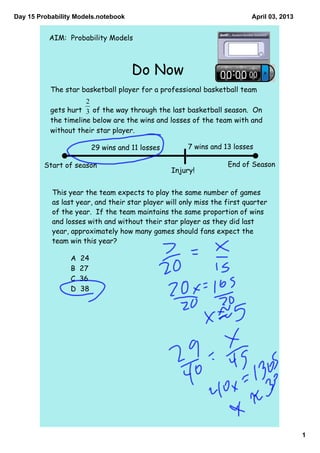
Day 15 probability models
- 1. Day 15 Probability Models.notebook April 03, 2013 AIM: Probability Models Do Now The star basketball player for a professional basketball team gets hurt of the way through the last basketball season. On the timeline below are the wins and losses of the team with and without their star player. 29 wins and 11 losses 7 wins and 13 losses Start of season End of Season Injury! This year the team expects to play the same number of games as last year, and their star player will only miss the first quarter of the year. If the team maintains the same proportion of wins and losses with and without their star player as they did last year, approximately how many games should fans expect the team win this year? A 24 B 27 C 36 D 38 1
- 2. Day 15 Probability Models.notebook April 03, 2013 Common Core Math Standard 7.SP.7 Develop a probability model (which may not be uniform) by observing frequencies in data generated from a chance process. For example, find the approximate probability that a spinning penny will land heads up or that a tossed paper cup will land open-end down. Do the outcomes for the spinning penny appear to be equally likely based on the observed frequencies? 2
- 3. Day 15 Probability Models.notebook April 03, 2013 Anticipatory Set Today we will create a Probability Model for spinning a penny and tossing a paper cup. A Probability Model is a mathematical representation of a random phenomenon, which includes the sample space and the probability associated with each event. Sample Space of Spinning a Penny: Sample Space of Tossing a Paper Cup: 3
- 4. Day 15 Probability Models.notebook April 03, 2013 Predicted Probabilities associated with Spinning a Penny: Predicted Probabilities associated with Tossing a Paper Cup: 4
- 5. Day 15 Probability Models.notebook April 03, 2013 Questions: 1.) Explain your predicted probabilities associated with Spinning a Penny. 2.) Explain your predicted probabilities associated with Tossing a Paper Cup. 5
- 6. Day 15 Probability Models.notebook April 03, 2013 6
- 7. Day 15 Probability Models.notebook April 03, 2013 Experimental Probabilities associated with Spinning a Penny: Experimental Probabilities associated with Tossing a Paper Cup: 7
- 8. Day 15 Probability Models.notebook April 03, 2013 Questions: 1.) How did your predicted probabilities compare with the experimental probabilities? 2.) What are the key differences between a penny and a cup that effects the probability models? 3.) How would you re-design the cup to increase the likelihood of the cup landing open-end down. 8
- 9. Day 15 Probability Models.notebook April 03, 2013 Coin Spin Unfair? If the coin is spun, rather than tossed, it can have a muchlargerthan50% chance of ending with the heavier side down. Spun coins can exhibit “huge bias” (some spun coins will fall tailsup 80% of the time). Coin Flipper 9
- 10. Day 15 Probability Models.notebook April 03, 2013 Homework Prepare for Friday's Probability Quiz 10
- 11. Attachments Develop a probability model.doc Day 12 Theoretical Probability.pdf